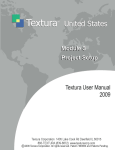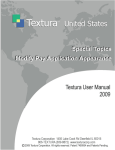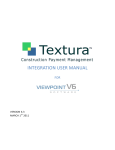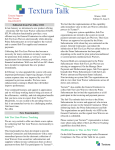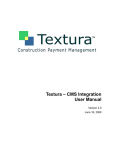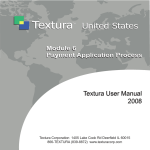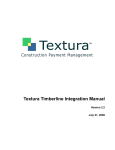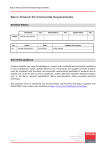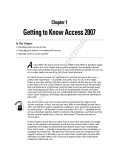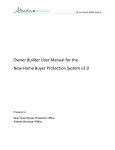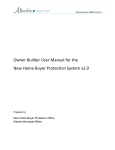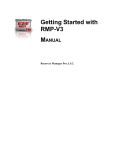Download Textura User Terms - Textura System::Login
Transcript
Textura User Terms Textura User Terms Above the Line Any organization on the system in Textura™ interested in the pay application process outside the actual submission of invoices is referred to as an "above the line" participant. Frequently an owner, but can also be an architect, title company, inspector and/or lender. ACAL See Additional Contractor Affidavit Lines accounting interface Accounting interface applications enable users to transmit data between their accounting software package and Textura™. accounting package Accounting software packages are computer applications frequently used by businesses to record and audit financial information. ACH See Automated Clearing House ACH transfer ACH transfer describes the process by which funds are moved from the disbursing organization's account to the payee's account electronically via the Automated Clearing House (ACH) when disbursement takes place in Textura™. Action In Textura parlance, an "Action" appears on your Home Page, Project Home Page, or Draw Home Page as a link to some task you should perform. Examples include: Enter Budget; Confirm Contract; Enter Invoice; Approve/Reject Invoice; Send to Signer; and Disburse Funds. Adjustment Adjustment columns appear on the user's Schedule of Values and are used to make modifications to line item amounts. Advance Billing Advance Billing gives the Contracting Organization the ability to invoice on a given line for an amount greater than its Self-Performed amount, provided it does not exceed the total Scheduled Value of the line. ATL See Above the Line Authorize In Textura™, to authorize means essentially to "sign off on" or approve. Authorize payments for disbursement Checking the "Require Disbursement Authorization for Subcontractor Payments" checkbox on the Project Settings page results in a project requirement for at least one authorizer. Textura users with this permission are required to "authorize" or approve each subcontractor payment prior to disbursement; there can be multiple authorizers. Textura™ User Manual © 2008 Page 1 Textura Corporation, Confidential Textura User Terms Authorizer Textura™ users in this role on a project are required to "authorize" or approve each Subcontractor payment prior to disbursement when the associated project setting is selected; there can be multiple authorizers on a project. Automated Clearing House Automated Clearing House (ACH) is one of the largest networks in the world for electronic financial transactions. ACH transactions are governed by the rules and regulations of the Federal Reserve in addition to NACHA, the industry association responsible for ACH payments. Automatic Split Payments ‘Cumulative Material Totals and Automatic Split Payments’ is a project setting indicating to the system that, when both Work Completed and Stored Materials are billed, the Contracting Organization automatically splits payment of a Subcontractor’s invoice. auto-populate Auto-populate is a term used to describe system functionality that results in fields being completed automatically with previously entered information. bank account # Bank account numbers are a unique identifier for a financial account at a specific financial institution. bank routing number Also known as a routing transit number, this nine digit bank code identifies the financial institution a negotiable instrument - such as a check - is drawn upon, and usually appears along the bottom, along with the account number and the check number, where applicable. Automated Clearing House requires this number to process electronic payments negotiated within the United States. Breakout Code Breakout Codes are often used in Textura™ to track pay application data for individual units of a multi-unit project. Assigning Breakout Codes to the Schedule of Values enables users to generate a single summary pay application for the entire budget with individual pay applications for each Breakout Code. Only the summary pay application is signed within the system. Document selections in Project Settings must support the use of Breakout Codes. Information about changing invoice appearance with Breakout Codes can be found in Special Topics. Change Order A contract modification in Textura™ that alters the contract quantities and/or value. C/O, CO See Change Order Classified To classify an attachment in the Textura™ system means to limit or restrict viewer access to particular users as determined by user permissions. Textura™ User Manual © 2008 Page 2 Textura Corporation, Confidential Textura User Terms CM See Compliance Manager Certificate of Insurance Evidence of insurance is given in the form of a Certificate of Insurance, a document issued by an insurance provider verifying the type and amount of coverage and the period for which it is valid. Examples of required insurance for which a certificate might be requested include: general liability, automobile, and worker's compensation. Complete Subcontract A subcontract is "complete" in Textura™ when all necessary data, such as Subcontractor organization name, associated parent phase code(s), and contract amount have been entered. Completed subcontracts are sent to the Subcontractor for confirmation. Completed Draws Draws for which funds have been disbursed are identified as "completed" in Textura™. Compliance In Textura™, compliance refers to a project participant's submission of materials, such as Certificates of Insurance or Lien Waivers, identified by the Contracting Organization or the system as required. Compliance Manager In Textura™, the Compliance Manager: creates compliance requirements (i.e., Legal Document Requirements); monitors contractor compliance; places or releases compliance-related payment holds; tracks sub-tier Lien Waivers; and rejects Lien Waivers. Component, Contract Component A subcontract in Textura™ can consist of multiple contract components, typically aligned with the Contracting Organization's cost codes. While contract components appear to the Contracting Organization as individual line items on the Contract Maintenance screen, they appear to the Subcontractor as individual boxes on the Edit SoV screen. Conditional Lien Waiver (final) A document that conditionally waives and releases all claimant lien rights on a project, provided the claimant has been paid. Conditional Lien Waiver (partial) A document used to conditionally waive and release all claimant lien rights on that portion of a project, in which the work has been completed, provided the claimant has been paid to date. Contract Currency Contract currency defaults to US dollars except where Multiple Currencies are selected in the Project Settings. Contract Currency selection(s) and the Exchange Rate applied in Textura™ are identified on the Contract Maintenance screen when the Contracting Organization creates the subcontract. Refer to Project Settings and Contract Administration for more detailed information. Textura™ User Manual © 2008 Page 3 Textura Corporation, Confidential Textura User Terms Contract Maintenance Screen within Textura™ where individual contract settings/options is displayed and can be edited. Contracting Organization In Textura™, the organization that has created/assigned a contract is the Contracting Organization. Often the General Contractor, but could also be a Prime Subcontractor or an Owner managing a project in the system. Contractor Affidavit The Textura™ system allows users to enter Contractor Affidavit information, if required, on the Lien Waiver. Contractor Affidavits enable Contracting Organizations to track material suppliers and/or subcontractors associated with a project and amounts contracted or paid to them. Users select the "Edit Additional Contractor Affidavit Lines" link from within the application to record this information prior to signing their Lien Waiver. Controlled Subcontract Used only with Linked Projects in Textura™ (refer to Special Topics), the controlled subcontract option enables the Contracting Organization to update their own SoV to reflect costs generated by another organization's project. CSV file A Microsoft Excel spreadsheet saved in the CSV (comma separated values) format, which can be used to upload an organization's budget into the Textura™ Schedule of Values. An example CSV file is available on the Edit Schedule of Values page. Cumulative Material Totals Cumulative Material Totals and Automatic Split Payments is a project setting indicating to the system that, when both Work Completed and Stored Materials are billed, the Contracting Organization automatically splits payment of a Subcontractor’s invoice. Disburse Company Funds Users with this permission have the authority to release company funds for ACH payment of a draw. Each company must give disburser privileges to at least one user in the organization and assign the disburser role to at least one user in each project. Disbursement Within Textura™, the process by which funds are directed from the disbursing organization to draw participants. Document Compliance Document Compliance in Textura™ allows users to record and view the status of documents required from Subcontractors before payment is released. Document Compliance requirements are determined by the Contracting Organization. Textura™ User Manual © 2008 Page 4 Textura Corporation, Confidential Textura User Terms Draw Draw refers to the periodic advance of funds from construction lender to developer/owner. Draws are generally scheduled at regular intervals throughout the construction process, according to level of completion attained. Textura™ users can initiate draws as needed or set up a draw calendar in the system to receive reminders when a draw should be initiated. Draw Context Draw Context refers to the frame of reference (or Draw #) attached to user actions, such as Change Orders or adjustments to the Schedule of Values, in the Textura™ system. Generally defined by the status of open draw(s) and whether events such as Send to Signer or Reject to PM have taken place. Also impacts the application of certain settings in Textura™, sometimes causing the system to reset data to the context of the previous draw. Draw Home Page Users have a Draw Home Page for each pending or completed draw. This screen provides access to all draw specific information. electronic lock box Electronic lockboxes are utilized by Textura™ to secure electronic remittance data (signatures) on Lien Waivers for a standard holding period to ensure that ACH payments are received prior to the release of signed Lien Waivers. Electronic Signature Electronic signatures, such as are executed in Textura™, are legally binding when applied to contracts and other documents according to the conditions defined under ESIGN, the federal Electronic Signatures in Global and National Commerce Act. To view this document, click here. E-mail Notification System-generated email messages are sent to Textura™ users, according to organization type and project user role, to give notice of a required action or communicate project/system information. E-Sign PIN Users who are eligible to sign or notarize documents in Textura™ are prompted to create a 4-6 digit Personal Identification Number (E-Sign PIN) to confirm the user's identity when electronically signing documents. first-tier Subcontractors operating directly under the Contracting Organization in Textura™ are called “first-tier.” Functional Currency Functional currency is either the default (US) currency for the project or, if Multiple Currencies are selected, it is the currency selected for the project by the Contracting Organization. Also see Contract Currency. Also see Primary Organization and Secondary Organization. Textura™ User Manual © 2008 Page 5 Textura Corporation, Confidential Textura User Terms Funding Organization The company name and address of the Funding Organization is displayed on all project draw documents (e.g., invoice, lien waiver) - as well as being used for ACH processing of disbursements. By default, the system uses the organizational information associated with the Primary Organization for this purpose, unless a Secondary Organization is selected on the Edit Project Funding page. GC See General Contractor General Contractor An individual or organization contracting with another individual or organization to execute the construction/reconstruction of a structure, infrastructure, or other building project. GMP See Guaranteed Maximum Pricing Guaranteed Maximum Pricing GMP is an amount that may be specified as the largest sum payable for a contract upon fulfillment. Handling Codes Handling Codes are used in Textura™ to draw specific data or SoV lines from the application to be used on a custom document. The specific use of Handling Codes is driven by the document selections in Project Settings. Information about changing invoice appearance with Handling Codes can be found in Special Topics. Hidden Change Order Hidden Change Orders modify the Current Value column but are not displayed in the Net Change by Change Order column on the Schedule of Values. They are also not identified as Change Order related values on the Pay Application documents. A Change Order can only be identified as Hidden when it is created, and the setting cannot be reversed. Hierarchical Invoice Code Multi-level, or hierarchical invoice codes can be custom tiered by the Contracting Organization to make more detailed subtotaling possible on invoices. More information about changing invoice appearance with Hierarchical Invoice Codes can be found in Special Topics. Home Page The Home Page is the starting point for users when logging into the Textura™ system. Links on the Textura Home Page provide access other areas of Textura™. While a menu in the left margin facilitates navigation to important areas of the application, a menu in the right margin facilitates navigation to user resources, such as the Online Help system, Frequently Asked Questions, and Tutorials. In the center of the Home Page, listings for My Actions, My Projects, and Other Projects make it possible for users to see at a glance whether they have pending actions, and quickly open the Project Home Page or messages on any project for which they have an assigned role. Textura™ User Manual © 2008 Page 6 Textura Corporation, Confidential Textura User Terms Incomplete Subcontract A subcontract that does not have all necessary data entered, such as subcontractor organization name, associated parent phase code, contract amount. Incomplete subcontracts have not been sent to Subcontractors for confirmation. Interface Documentation User guides created to assist users in transmitting data between their accounting software package and Textura™. interface accounting interface Internal Project Number Internal Project Numbers or Job Numbers, generally unseen by external parties, appear only on the pages of the user's organization. Above the line participants may be able to view the Internal Project Numbers that the Contracting Organization has assigned, but they are unable to assign or edit the numbers themselves. Internal Project Numbers are assigned in Project Settings by a user who has the permission to manage projects. invoice The instrument used by the Subcontractor or the Contracting Organization to submit their billing for payment is the invoice. Invoice Codes Invoice Codes allow you to subtotal two or more line items in your Schedule of Values and display only the summary line or both the summary line and detail on the continuation sheet of your pay application. Although Invoice Codes are frequently used to group and subtotal line items by division or by project phase, they are completely configurable, and can be used to identify any specific order or grouping on your Schedule of Values. Information about changing invoice appearance can be found in Special Topics. Invoice Cover Sheet Pay application document optionally available in generic or customized form in the Textura™ system. joint check Textura™ disburses via ACH to the first-tier subcontractor and the joint payees are paid via manual check. Joint checks must be endorsed by both the first- and second-tier Subcontractors. joint payee Typically, joint payee refers to a material supplier or sub-tier subcontractor paid directly by the Contracting Organization via a joint check - a situation supported in Textura™ via our Split Payment functionality. legal document Any document required by the Contracting Organization for a specific project. Legal documents may include: insurance certificates, contractor affidavits, worker’s compensation forms, etc. Textura™ User Manual © 2008 Page 7 Textura Corporation, Confidential Textura User Terms Legal Document Compliance See Document Compliance Legal Document Requirement (Legal) Document Requirements are determined by the Contracting Organization in Document Compliance, and may include: certificates of insurance; signed contracts; W-9 forms; pre-qualification documents; safety packets; certified payroll; or any other document identified by the Contracting Organization. Legal Document Status (Legal) Document Status is determined by the submission or non-submission of required compliance documents for the project. Lien Waiver A Lien Waiver releases all or a portion of the claimant’s (mechanics) lien rights to a property. Lien Waiver Signature Timing Lien Waiver Signature Timing is a Project Setting in Textura™ that determines at what point in the draw process the signing and submission of Lien Waivers are requested. Lien Waiver Tracking Lien Waiver Tracking in Textura™ is a feature that enables the Contracting Organization to track all Lien Waiver submissions by draw, including: Subcontractors paid on-system (through ACH); on-system Subcontractors paid off-system (by manual check); and off-system Subcontractors who are known to Textura only through Lien Waiver Tracking. Linked Project Linked Project is an advanced feature in Textura™ that allows individual organizations to maintain separate budgets within Textura™, having different line items, values, and phase codes for the same physical project. Invoice amounts can be uploaded from one project to another during each draw in order to create a summary view of all costs associated with a project. Refer to Special Topics. Local Administrator A Local Administrator in Textura™ has the ability to edit their own profile and other users in the project, alter/edit organization information including bank account information, and can perform project tasks including designating user roles. Refer to Module 2 for additional detail. LW See Lien Waiver Manage Classified Attachments Users with the Manage Classified Attachments permission are able to designate uploaded attachments as "classified," or inaccessible to unauthorized users within the organization. These users can upload, view, classify, or un-classify attachments. It is not a project user role or a required permission in Textura™. Textura™ User Manual © 2008 Page 8 Textura Corporation, Confidential Textura User Terms Manage Compliance Users with the Manage Compliance permission can create compliance requirements (i.e., Legal Document Requirements,) monitor contractor compliance with those requirements, place or release compliance holds, and reject lien waivers. Manage Projects Users with the Manage Projects permission can set up and manage projects in Textura™, including creating projects, assigning user roles, entering a schedule of values, entering invoices, managing subcontracts, allocating change orders, and approving invoices. Manual Check The Manual Check option is selected when the Contracting Organization finds it necessary to pay a Subcontractor or Material Supplier by paper check rather than electronically through ACH. Message See Project or System Message Manual Subcontractor A Subcontractor that is not directly participating in Textura™ is known in Textura™ as a Manual Subcontractor. Generally this is a Subcontractor for whom the General Contractor wants to track Lien Waiver submissions for compliance reasons. notarize documents Documents in Textura™ are notarized electronically where required. Electronic notarization generally follows the same rules as manual notarization. Documents must be signed and notarized on the same computer; however, the signer and the notary cannot be the same user. Any notary on the Textura™ system can notarize a signature; they need not belong to the same organization or be assigned to a project. notary A notary public is an officer who can administer oaths and statutory declarations, witness, authenticate documents, and perform other duties that vary from jurisdiction to jurisdiction. A Notary signature is often required on Legal Documents, such as pay applications, invoices, lien waivers, and sworn statements. off-system Subcontractor or material suppliers whose organizations do not electronically sign documents within Textura™ are referred to as "off-system". Online Help Catalogue of information designed to assist with using the Textura™ application. on-system Any organization that is set up in the Textura™ system via invitation and possesses user rights is referred to as "on-system.” Users can be “Above the Line” Owners, Architects, Lenders, Title Companies, etc., or they can be the “Contracting Organization” that holds the primary contract for the project(s). They may also be Prime Subcontractors, Subcontractors, or material suppliers; on system contractors and material suppliers manage their budget and submit invoices for payment through the system. Open Book Textura™ User Manual © 2008 Page 9 Textura Corporation, Confidential Textura User Terms At the project level, the open book setting provides participants (e.g. owners, lenders) above the Contracting Organization with visibility into the Contracting Organization and first-tier Subcontractors' project details. Set at the contract level, open book provides the Contracting Organization with visibility into second-tier Subcontractors' project details. Set at both the project and contract level, the Owner has full visibility, including first- and second-tier Subcontractors' project details in addition to those of the Contracting Organization. Organization Role The role or function the organization will assume within the Textura™ system. Organization roles include: Title Company, General Contractor, Subcontractor, Off-System Subcontractor, Architect, Material Supplier, Off-System Material Supplier, Project Owner, Lender, Other, Supervisory Organization, Funds Disburser, Subsidiary Organization, and Disbursing Subcontractor. Organizational Profile Pertinent information for a specific organization, including: Company name, address, phone number, organization type, bank information. Parallel Signatory Approval Parallel Signatory Approval is a contract setting that requires one or more authorized parties within the organization to sign off on selected Subcontractor Pay Application documents. Multiple signatory approvals can be applied in any sequence. Password Character and numeric code used in conjunction with a username to log into the Textura™ system. Password Expiration Passwords expire in Textura™ automatically according to the frequency selected in the organization profile (Edit Primary Organization). Pay Application A Textura™ Pay Application is composed of a selection of documents specified by the user in Project Setup, prepared by the system with user input and presented for signatures to finalize before submitting in exchange for payment. Pay Applications are generated by each on-system project participant for work completed during the specified draw period. Pay Applications typically include a G702/703 and a Lien Waiver, and may also include a Cover Sheet, Sworn Statement or other custom document. Payment Receipt When payment has been disbursed in Textura™, Subcontractors receive an email notification and an action to view their Payment Receipt, confirming that ACH payment has been transmitted. The date processed, Amount Approved, and any applicable fees appear on the Payment Receipt. PCCO See Prime Contract Change Order Textura™ User Manual © 2008 Page 10 Textura Corporation, Confidential Textura User Terms PDF Portable Document Format (PDF) was created by Adobe Systems and can be viewed by Adobe® Acrobat®. All documents in Textura™ including invoices, sworn statements, and lien waivers, are PDF documents. Pending Draws Draws that have been initiated but are not yet disbursed are referred to as "Pending." Permissions In the Textura system, permissions are assigned to users by the organization's Local Administrator via the Edit User page. Permissions identify what a user can do in the system, such as: Manage Projects Manage Compliance Authorize payments for disbursement Sign on behalf of the company Manage Classified Attachments Disburse Company Funds Notarize Documents Personal Identification Number Users who are eligible to sign or notarize documents in Textura™ are prompted to create a 4-6 digit Personal Identification Number (E-Sign PIN) to confirm the user's identity when electronically signing documents. Organization Profile The Organization Profile in Textura™ contains pertinent information for a specific organization, including: company address, phone number, organization type, Tax ID, Bank Information, and accounting package, if applicable. Phase Code Phase codes are used to organize budget line items (work breakdown) in a schedule of values. Textura™ accepts alpha-numeric text phase codes (e.g. 300.100, 100a, work 3, N03300), which are sorted upon saving based on the first character in the field. For example, if you have more than 100 line items in your schedule of values, leading zeros must be used to sort numerically (001, 002, 003, 004, 005, 006, 007, 008, 009, 010, 011, etc.). PIN See Personal Identification Number (E-Sign PIN) PM See Project Manager populated Fields containing data in an online application are referred to as "populated." Textura™ User Manual © 2008 Page 11 Textura Corporation, Confidential Textura User Terms Primary Organization In Textura™, the organizational information that is entered on the Edit Organization page defines the profile of the primary organization. This information is used to populate all project draw documents and for ACH disbursement processing. Users may designate a secondary organization to appear on documents and for funding project disbursement; however, any funds due to the organization are deposited to the bank account of the primary organization. Prime Subcontractor Subcontractors who manage their Subcontractors' or material suppliers' invoicing through the system are known as Prime Subcontractors. Sub-tier organizations submit their invoices to the Prime Subcontractor for review and approval in Textura™. The Prime Subcontractor can then roll the costs into their invoice to the General Contractor. All documents are collected electronically. Prime Contract Change Order The Contracting Organization creates a Prime Contract Change Order (PCCO) to increase or decrease the project budget (contract) value. Assuming they are not “Hidden,” Change Order amounts appear on the appropriate line or lines of the Contracting Organization’s invoice document. After creating the Change Order, the Project Manager can go directly to the Schedule of Values page to modify the budget, or follow the link in the system generated email message. Until a PCCO is allocated, the SoV remains Out of Balance. Project Actions Project Actions appear on the Project Home Page as a link to a task you should perform. Examples include: Enter Budget; Confirm Contract; Enter Invoice; Approve/Reject Invoice; Send to Signer; and Disburse Funds. Project Home Page Users have a Project Home Page for each project in which they are assigned a project user role. This screen provides access to all project specific information. Project Manager The Project Manager (PM) sets up and manages projects in Textura™, including: creating projects; assigning user roles; entering a schedule of values; entering invoices; managing subcontracts; allocating change orders; and approving invoices. Project Messages Project messages relate to a user’s role on a specific project and often indicate that the system is waiting for you to take some action on the project. Some examples include: Enter Invoice, Sign Lien Waiver, and Ready to Disburse (funds). Messages may also be informative, indicating that a project action has been taken by someone else, either inside or outside of your organization, including: Project Participation Confirmed, Draw Initiated, and Invoice Details Updated. Project Role Access rights of a user for a specific project. Users may only be assigned project roles that their 'user can' permissions have been set for. Textura™ User Manual © 2008 Page 12 Textura Corporation, Confidential Textura User Terms Project Settings In the Project Settings the user defines the project details that determine how the system manages project participants, processes, and documents. Project Setup Project Setup is the process of entering the project specific information and settings in Textura™. This includes: creating the project; entering the appropriate information and settings; assigning users to the project; assigning funding information via a primary or secondary organization; and setting up the draw calendar. radio button A graphical user interface element that allows the user to select only one choice from a set of predefined options is known as a “radio button”. Reallocation Reallocation in Textura™ means to redistribute values on the SoV without changing total amounts, which requires a Change Order. Regular User Regular users can perform all necessary actions within the Textura system that correspond to their assigned permissions. They are unable to perform tasks reserved for Local Administrators. Require Disbursement Authorization for Subcontractor Payments Require Disbursement Authorization for Subcontractor Payments creates the need for an authorizer role on the project whose approval is required prior to disbursement. retention Retention is a percentage amount that is withheld from payment at the discretion of the Contracting Organization and according to specific subcontract details. Typically made available toward the end of the project or in the final draw, the release of retention in Textura™ is treated as part of the standard draw process: i.e., organizations request retention on an invoice and sign a Lien Waiver. routing number bank routing number Schedule of Values The Schedule of Values (SoV) is the budget, based on the contract for the project, and containing line items showing the work breakdown. SCO See Subcontract Change Order Textura™ User Manual © 2008 Page 13 Textura Corporation, Confidential Textura User Terms Secondary Organization A General Contractor may have several legal entities they use, each linked to the primary organization and having its own name, address, FEIN, and bank account. Entering these legal entities and their corresponding information as Secondary Organizations for payments and legal documents enables one system organization to use different organizational information for individual projects on the Setup Project Funding screen. Self-Performed ‘Self-performed’ represents work and/or fees of the Contracting Organization; in the Textura™ system, an invoice line on which this cost can be accounted for and rolled up into the total for the line item. Serial Signatory Approval Serial Signatory Approval is a contract setting that requires one or more authorized parties (other than the Project Manager) within the organization to sign off on selected Subcontractor Pay Application documents. Serial Signatory Approval is applied in a pre-determined sequence. Setup Document Requirements Compliance (legal document) requirements are determined by the Contracting Organization on the Setup Document Requirements page. Sign on behalf of the company Users with permission to 'Sign on behalf of the company' are the only users authorized to sign documents such as invoices, sworn statements, and lien waivers. A user with this permission will be prompted to set up a unique PIN for use when signing documents in Textura. Each project must have a signer. Signer One or more Signers is identified for each project to sign documents such as invoices SoV See Schedule of Values Special Budget The Special Budget feature provides a utility to track an alternate Schedule of Values to be used in generating customized pay applications while still enabling the control features expected of the Textura™ application. Refer to Special Topics. Special Topics More advanced functionality and/or features requiring customization, such as the integration of accounting interfaces, are covered in Special Topics. Specified Billing Specified Billing is a contract setting that enables the Contracting Organization to create and manage the Subcontractor invoice. The Subcontractor views and approves or rejects the invoice in Textura™. May be set as the default in Project Settings and removed as appropriate. Look for Specified Billing in Special Topics. Textura™ User Manual © 2008 Page 14 Textura Corporation, Confidential Textura User Terms Specified Schedule of Values (SoV) Specified SoV allows the Contracting Organization (General Contractor or Prime Subcontractor) to directly create and change the phase codes, phase code descriptions, and the original and adjusted Schedule of Values for the Subcontractor. Split Payment The Split Payment option is selected when the Contracting Organization wishes to divide a payment in Textura™. Examples of situations in which a single payment might be divided: to issue a check or joint check to one or more sub-tier organizations or suppliers; to reduce a payment to a Subcontractor due to a prior advance of funds outside of Textura™; or, to take a discount based on contract terms. The affected Subcontractor in Textura™ must approve the split payment prior to disbursement. Subcontract Change Order Subcontract Change Orders (SCO) are created to modify the contract value of an existing subcontract. Upon creation of the SCO, Textura™ generates an email notifying the Subcontractor that there are unallocated Change Order(s) and furnishing a link to their Project Home Page, where the SoV tab appears in red. The Subcontractor’s SoV remains out of balance until all Change Order(s) are allocated. Subcontractor Subcontractors in Textura™ are invited by a Contracting Organization to set up and manage an account Typically, they create and sign their documents in the system, receiving payment via ACH. Subcontractor Invoice Approver The Subcontractor Invoice Approver role is assigned to approve Subcontractor invoices; required where Signatory Approval of Subcontractor Invoices is used. Sub SoV Option A contract setting in Textura™, Sub SoV Option determines what level of control the Contracting Organization retains in the administration of the subcontract. Contracts default to “None”, meaning that the Subcontractor has full control over their SoV. Specified SoV makes the Contracting Organization responsible for entering and modifying the Subcontractor’s SoV; while Review SoV triggers an email to the Contracting Organization whenever changes are made to the SoV by the Subcontractor. sub-tier Organizations that belong to the second tier below the Contracting Organization are classified as “subtier.” Supervisory Organization Supervisory Organization is a general description meant to include any organization that requires "View Only" access to project information, but is not playing an active role (e.g., approving the draw, signing the payment application, disbursing funds) as an Above the Line participant in the project on Textura™. Supervisory Organizations can include, but are not limited to: Title Companies, Owners, Architects, Lenders, Accountants, Inspectors, and Consultants. SWIFT code The 8 to 11 character SWIFT (Society for Worldwide Interbank Financial Telecommunication) code uniquely identifies a particular bank and is used for the transfer of funds internationally. Sworn Statement Textura™ User Manual © 2008 Page 15 Textura Corporation, Confidential Textura User Terms A sworn statement is a declaration of a (Sub)contractor’s work performed. As any document in Textura™, sworn statements may require notarization. System Messages System messages are associated with your individual profile as a user of the system and within your organization. They are generally not project specific and may indicate that an action needs to be performed. Some examples include: Reset E-Sign PIN, Responsibilities Changed, Your Profile Has Been Updated, and notices regarding signatory approval. Tax ID# The Tax ID# requested in Textura™ is also known as an Employer Identification Number (EIN) or Federal Employer Identification Number (FEIN). This 9 digit number is assigned by the Internal Revenue Service (IRS) to businesses within the United States. A business owner's social security number may be used where a FEIN is not available. Tax Increment Financing A financing mechanism used by municipalities to fund a project through a combination of conventional budget allocation and funds from new (incremental) taxes levied. TIF projects usually require special reporting which segregates the conventional funds from the TIF funds. Terms and Conditions All organizations using Textura™ must accept our User Agreement, the Textura Terms and Conditions. Textura Talk Textura Talk is a newsletter publication sent via email to Textura™ users. Textura User Setup Manual The Textura User setup Manual provides detailed instructions for getting your organization set up on the Textura™ system. A link to the Textura User Setup Manual is included in the invitation email. T's & C's See Terms and Conditions Tutorials Captivate® video simulation training tutorials are provided to offer a visual overview of the steps typically taken to perform certain individual tasks such as creating a project or submitting an invoice for payment. These topics are covered in greater detail in the Online User Manual modules. Unconditional Lien Waiver (final) A document that unconditionally releases all rights of the claimant to place a lien on the owner’s property. Unconditional Lien Waiver (partial) A document that unconditionally releases all rights of the claimant to place a lien on the owner’s property through the date indicated. Textura™ User Manual © 2008 Page 16 Textura Corporation, Confidential Textura User Terms Unit Pricing Unit Pricing enables project participants to invoice/bill by the quantity used or completed User can “User can” permissions are determined for each organization by its Local Administrator and include: manage projects; manage compliance; sign on behalf of the company; authorize payments for disbursement; disburse company funds; manage classified attachments; and notarization of documents. User Profile The User Profile in Textura™ contains pertinent information for a specific user, including: name, title, phone number, user role, email, user can permissions, and/or notary information. User Roles Roles for users in the system include: Local Administrators, Regular Users, and View Only Users. User roles determine the level of access and responsibility a user has in the system, i.e., what they are allowed to do. Username Unique identifier to link a user with their user profile within Textura. Usernames can be alpha numeric, up to 20 characters in length, and must be unique within the Textura system. View Only User View Only users are able to view many project details without taking any actions. webinar A webinar is a training session that takes place over the Internet in real time. widget Widget is a generic term for a piece of "code" that allows users to instruct an application (or web page) to perform a particular calculation based on user input and display the results in a predictable form. Often used in a graphical, rather than textual, context. Zero Dollar Lien Waiver In areas where the law requires it, Subcontractors that have invoiced on a previous draw must submit lien waivers for each successive draw, even those for which they have no billing. These lien waivers are referred to as 'zero dollar lien waivers.' Textura™ User Manual © 2008 Page 17 Textura Corporation, Confidential



















